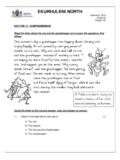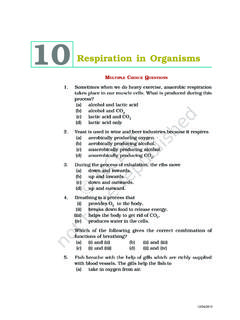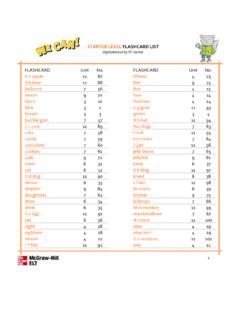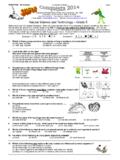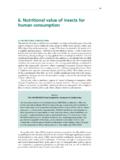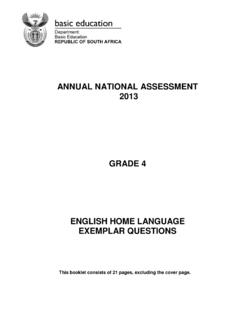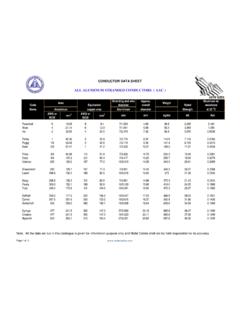Transcription of Quick Guide to Classification of the Animal Kingdom
1 Quick Guide to Classification of theAnimal KingdomNOTES: You can use these as single pages, or you may want to cut and tape them into one very long chart to hang on a wall (so you can see the entire Kingdom at once). Notice that the Classification categories (phyla, class, order, family) are not only typed in the same font, but also line up vertically (all have the same amount of indent). In other words, if you hold a ruler vertically under the word Class, all the classes will be right along the edge of the ruler. Knowing Greek and Latin root words can help you decode what these complicated-looking names mean. Often they mean something very simple, like big nose. If you need help with pronunciation, consult a dictionary. The dictionary will have the word spelled out phonetically and will tell you which syllable gets the A GAME: Try playing a 20 Questions game where one player thinks of an Animal and the others try to guess what it is using only yes or no questions.
2 You can use the categories to help narrow down the possibilities very quickly. MUSIC: I have written three science songs that teach Classification : The Classification Song, The Marine Invertebrates Song, The -Optera Song of Insects, and The Arthropods Song. They are on The Science Jukebox CD, availble through either my website or (You can download single songs on ) If you download them and need the lyrics, they are printed on the last page of this pdf DISCLAIMER: I am not a professional zoologist. All the information for this chart came from books and websites that I consulted. If you find any discrepancies, email me and let me know. Thanks! Here are a few of the most common Latin/Greek word roots. This is not an exhaustive list, just some of the more common roots you ll see in withoutamphi/ambi both arthro jointbi twobrachi armcephalo headcervid deercervix neck chilo/chello lipchiro handchondro/chondra cartilagecnida stinging nettle (a plant) (the c is silent; say ni-da )coelen hollowcteno comb (the c is silent.)
3 Say ten-o ) coleo sheeth or scabbard (the covering for a sword)derm/derma skindi/diplo twodicty net (like a fishing net)echino spinyequus horsegastro stomachhippo horsehydro/hydra waterhymen membranehyper overhypo underiso equal or samelepido scale or scalymacro argemicro smallmoll softmorph shapemyo muscleortho straightosteo boneodont toothoto earpinna wing or featherplaty flat or broadpleuro side or ribpod/ped footptera wingsiluri a kind of fishsyn withtachy swifttetra fourtri threeura tailKINGDOM PHYLUM SUB-PHYLUM Class Order Family Kingdom ANIMALIA ROTIFERS microscopic creatures such as philodina and rotaria NEMATODES roundworms (includes hookworms, pinworms and vinegar eels)
4 ANNELIDS segmented worms such as the common earthworm PLATYHELMINTHES flatworms such as the planaria and the fluke PORIFERA sponges CNIDARIA (also called COELENTERATES) jellyfish, hydra, sea anemones, corals CTENOPHORES comb jelly ECHINODERMS starfish, sand dollars, sea urchins, sea lilies, sea cucumbers MOLLUSKS Cephalopods: (means head foot ) octopus, squid, nautilus Gastropods: (means stomach foot ) slug, snail, abalone, limpet, and others with one shell Pelecepods: (means hatchet foot ) (also called bi-valves ) clam, oyster, mussel ARTHROPODS Insects Coleoptera: beetles and weevils Dermaptera: earwig Dictyoptera: cockroach and mantis Diptera: flies Hemiptera: true bugs such as shield bug Hymenoptera: ant, bee, hornet and wasp Isoptera: termite Lepidoptera: butterflies and moths Odonata: dragonfly and damselfly Orthoptera: grasshopper and cricket Siphonaptera: flea Arachnids: spiders, ticks, scorpions, harvestmen ( granddaddy long legs ) Crustacea: crab, lobster, water flea, daphnia, copepod Chilopoda.
5 Centipedes Diplopoda: millipedes CHORDATA SUB-PHYLA CEPHALOCHORDATA the amphioxus (a strange form of sea life) TUNICATES sea squirts VERTEBRATES (see next page) page 1 NOTE: If you would like to know the genus and species for a certain Animal , you can find this information listed on the Wikipedia article about that Animal (on the Internet). PHYLUM SUB-PHYLUM Class Order Family VERTEBRATES Placoderms (extinct fish) Agnatha Lamprey Hagfish Chondrichthyes (cartilaginous fishes) Pleurotremata: sharks Hypotremata: rays, sawfish Osteoichthyes (bony fishes) Anguilliformes: conger eel, moray eel Atheriniformes.
6 Flying fishes Cypriniformes: goldfish, carp, piranha, minnow, electric eel Cyprinodontiformes: black molly Gadiformes: cod, whiting Gasterosteiformes: seahorse, stickleback, leafy seadragon, pipefish Perciformes: grouper, beat, mackerel, parrot fish, goby, angel fish, perch, wrasse, clownfish, remora, snapper, surgeonfish, bass, barracuda, cichlid Pleuronectiformes: sole, halibut, turbot (flat fishes) Salmoniformes: trout, salmon, viperfish Scorpaeniformes: scorpionfish Siluriformes: catfish Synbranchiformes: swamp eel Tetraodontiformes: blowfish, triggerfish, porcupine fish Amphibia Urodeles Salamandridae: salamanders and newts Anurans Ranidae: bull frog, green frog Dendrobatidae: poison dart frog Bufonidae.
7 Common toad Pipidae: Surinam toad Hylidae: European tree frog Discoglassidae: firebelly frog Reptilia Squamata (lizards and snakes) Sub-order Sauria (lizards) Geckonidae: gecko Chamaeleonidae: chameleon Iguanidae: iguana, lizards, anole Helodermatidae: gila monster Varanidae: monitorpage 2 PHYLUM SUB-PHYLUM Class Order Family VERTEBRATES (continued) Reptilia (continued) Sub-order Ophidia (snakes) Colubridae: grass snake, rat snake, king snake, tree snake Viperidae: viper, adder, asp Crotalidae: rattlesnake moccasin, bushmaster Boidae: boa, anaconda, python Elapidae.
8 Spitting cobra, mamba, coral snake Hydrophidae: sea snake Chelonia (turtles) Cheloniidae: sea turtle Testudinidae: tortoise Emydidae: painted turtle Chelydridae: snapping turtle. box turtle Trionychidae: soft-shelled turtle Crocodilia (crocodiles and alligators) Alligatoridae: alligator, cayman Crocodilidae: crocodile Aves (birds) Anseriformes: duck, swan, goose Apterygiformes: kiwi Charadriiformes: gull, tern, puffin, sand piper Ciconiiformes: stork, heron, bittern, ibis, spoonbill Columbiformes: pigeon, dove Coraciiformes.
9 Hornbill, kookabura Galliformes: chicken, turkey, pheasant, quail Falconiformes: hawk, falcon, vulture Passeriformes: perching birds such as the blackbird, myna bird, and most common song birds we see every day Pelicaniformes: pelican, gannet, cormorant Piciiformes: toucan, woodpecker Procellariiformes: petrel, albatross Psittaciformes: hookbills such as the parrot, cockatiel and cockatoo Rheiformes: rhea Sphenisciformes: penguin Strigiformes: owls Struthioniformes: ostrichpage 3 PHYLUM SUB-PHYLUM Class Order Family Mammalia Monotremes: (egg-laying mammals) platypus, echidna Marsupials: (have a pouch) Phalangeidae: koala, dormouse, cuscus, brush-tail opossum Peramelidae: bandicoot Macropodidae: kangaroo, pademelon Didelphidae.
10 Woolly opossum Dasyuridae: dasyure, marsupial mouse Artiodactyls: (hoofed mammals with even number of toes) Antilocapridae: pronghorn Peramelidae: antelope, gazelle, gnu, yak, goat, chamois, sheep, ibex, bison, eland, zebu, oryx, dik-dik, kudu, duiker Camelidae: camel, llama, alpaca Cervidae: muntjac, deer, moose, elk, caribou Giraffidae: giraffe, okapi Hippopotamidae: hippopotamus Moschidae: musk deer



